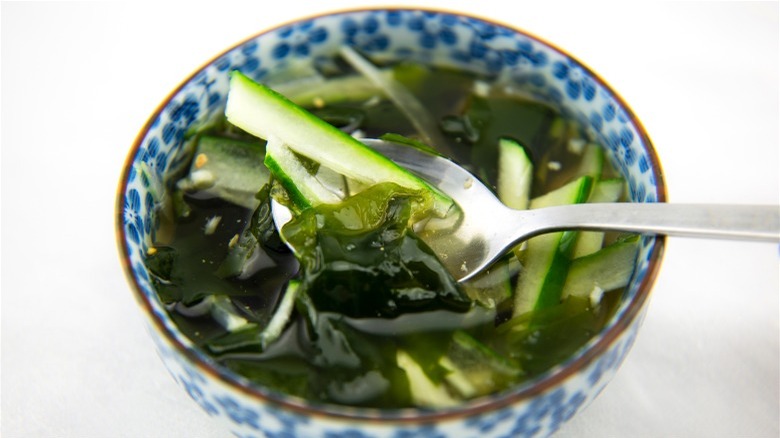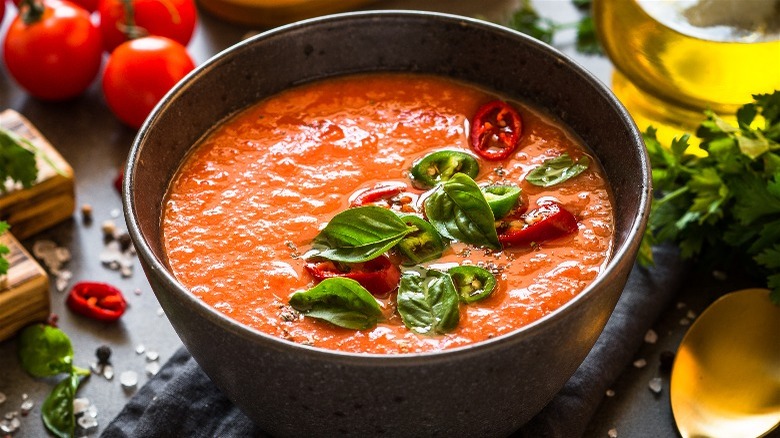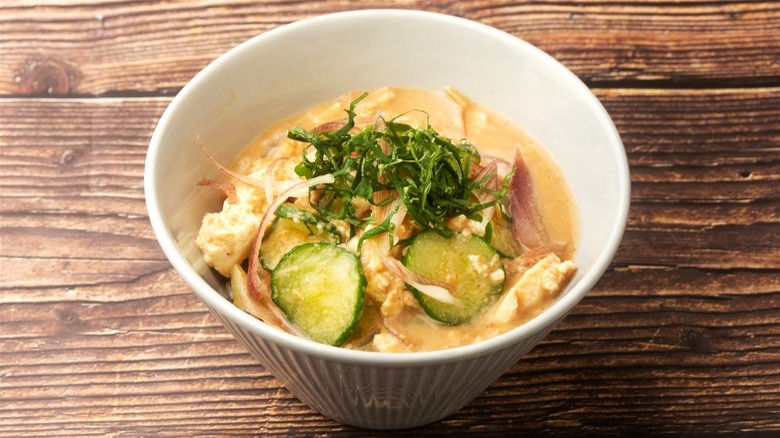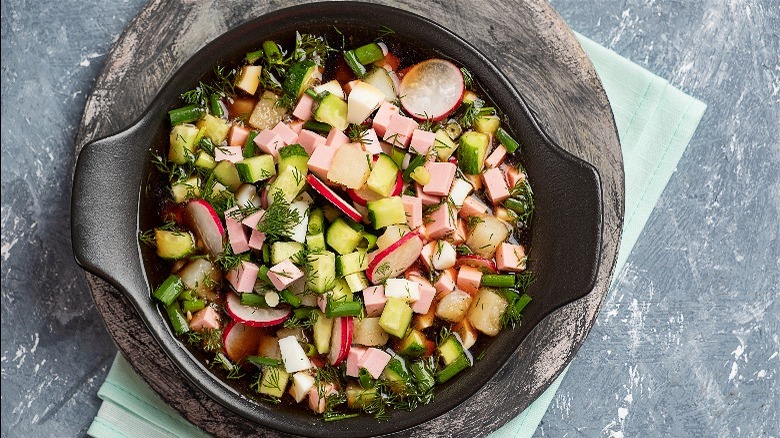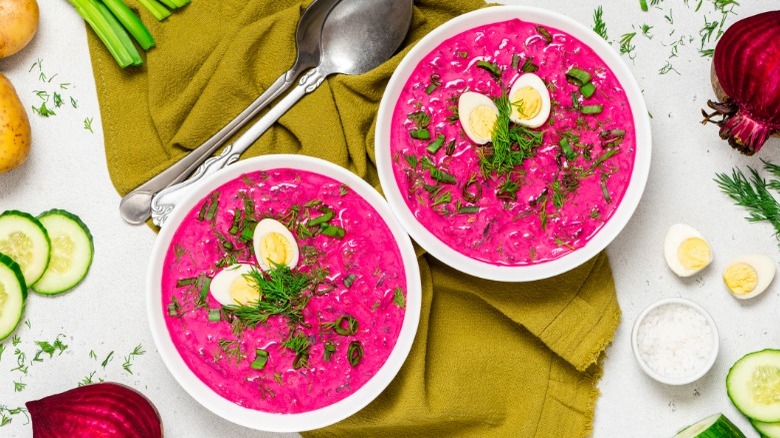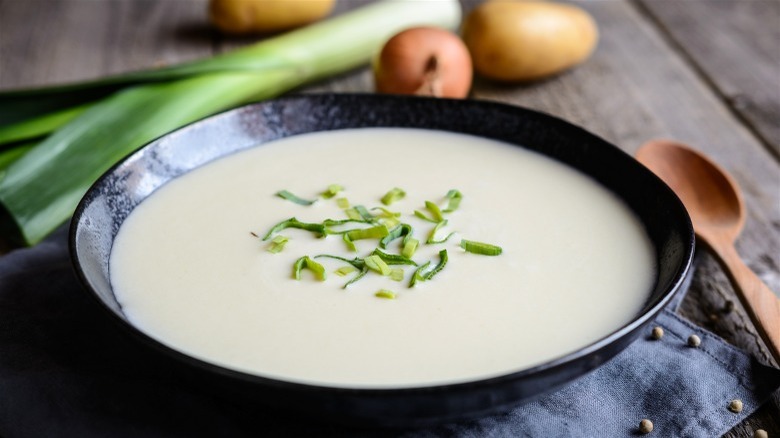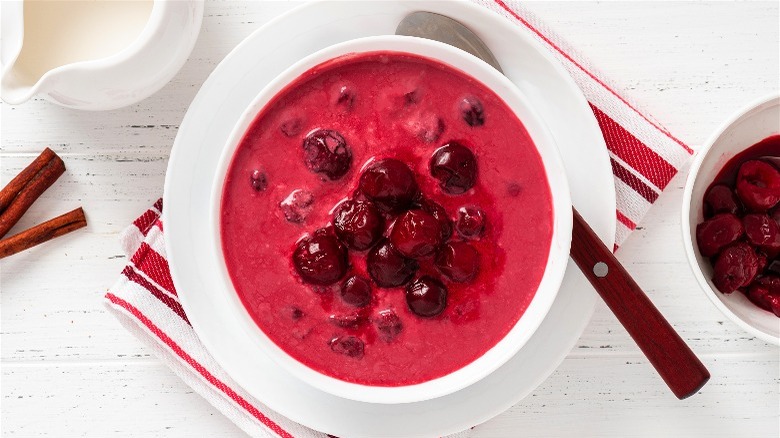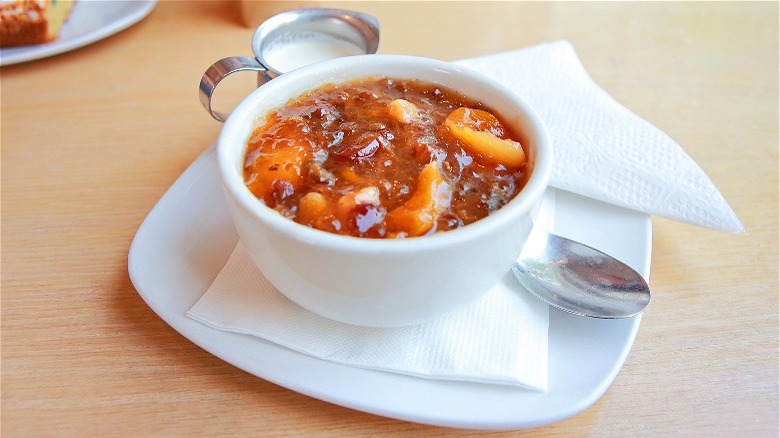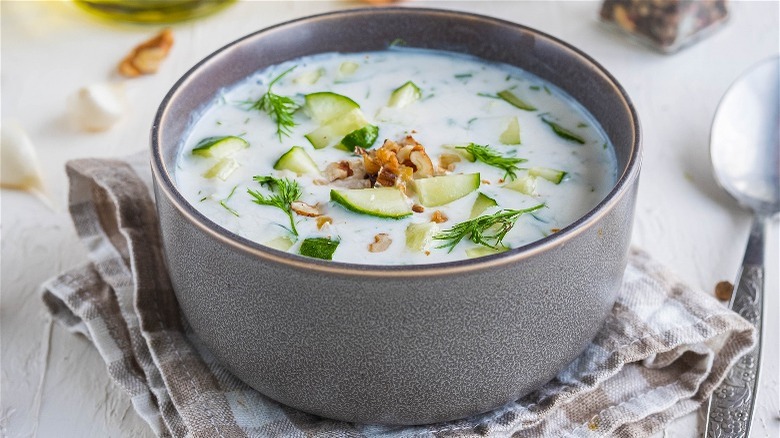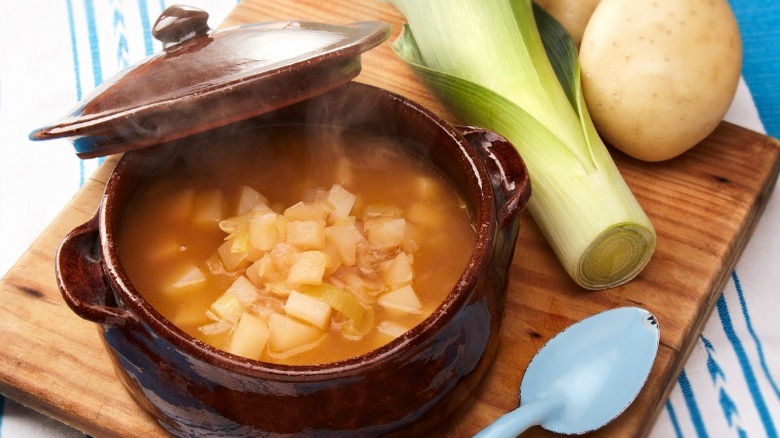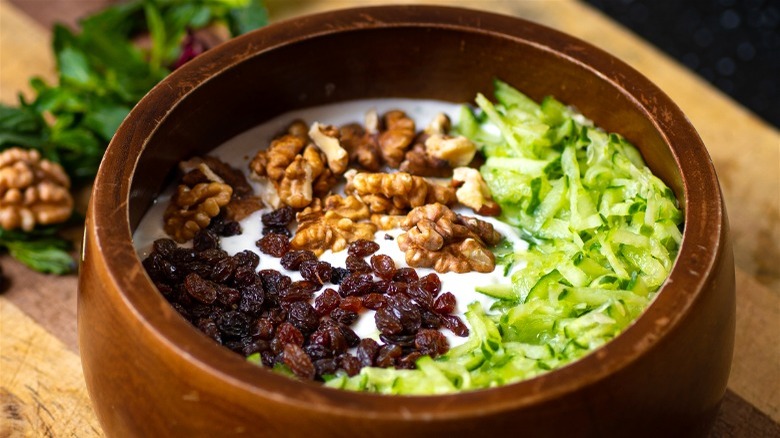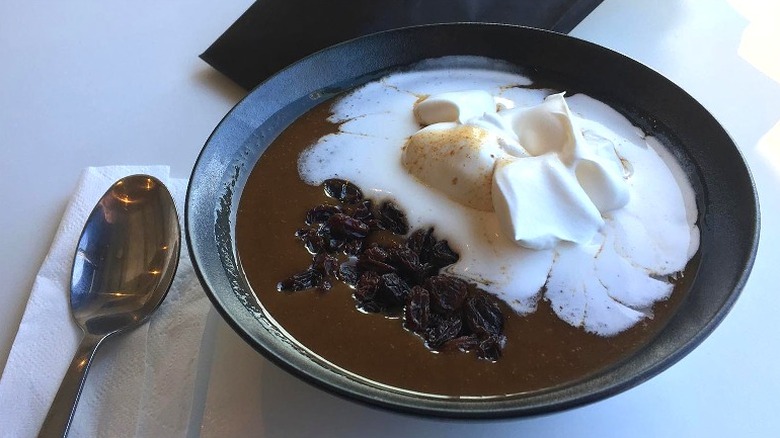13 Cold Soups From Around The World You Should Know For Summer
With summer in full swing, and the temperatures rising around the globe, a bowlful of liquid refreshment can come to the rescue, cooling our bodies and calming our souls. Fortunately, each corner of the world boasts its unique, invigorating cold soup recipe, many of them naturally vegetarian or easily vegan-ized. From familiar vegetable purees like Gazpacho and Vichyssoise to iced oi Nnaengguk, yogurt-based ab doogh Khiar and tarator, vibrant chłodnik and hideg meggyleves, and even those soups that are heavily leaning into the dessert realm — there is something for everyone.
Often born out of scarcity and poverty, or, conversely, brought about as abundant harvest celebrations, these soups are a testimony of the peculiarities of cuisines around the world — from Menorca, Spain, to Iceland, Iran, South Korea, and beyond. Many of them have been carried around the world and passed down through generations of immigrant families. They have proudly outlived many of their contemporaries and are here to expand your summer culinary repertoire. So dive into the refreshing world of cold soups, and let them help you beat the heat.
South Korean Oi Naengguk
Iced coffee may be your go-to summer refreshment, but have you ever considered an iced soup to beat the heat? Introducing: oi naengguk, a South Korean chilled soup that's as invigorating as it is flavorful. The word "oi" stands for "cucumber," while "naengguk" refers to cold soups, painting a clear image of what's to come.
You could try it with any cucumber you have on hand, but Persian, English, or Kirby are your best bet. In one variation of the soup, the juicy crunch of cucumbers is beautifully offset by the soft, slightly slimy miyeok — a type of sea vegetable more commonly known by its Japanese name, wakame. Can't find wakame? No worries, just toss in more cucumbers instead.
The best part about oi naengguk is that there's no cooking involved. Just slice cucumbers into thin matchsticks, mix with garlic, green onions, red pepper, and sesame seeds, add the wakame, and drown in a tangy broth of soy sauce and vinegar. You can also add buckwheat noodles for a more filling meal or some sliced cherry tomatoes for a splash of color. Plate with a few ice cubes and savor the revitalizing pleasure of this simple, vegan-friendly Korean treat.
Spanish gazpacho
A cultural cornerstone hailing from Spain's Andalusian region, Gazpacho is a refreshing, world-renowned cold soup so iconic that its name often serves as a catch-all term for any cold vegetable or fruit soup. The quintessential gazpacho is a harmonious blend of tomatoes, onions, garlic, and bell peppers, emulsified with oil and vinegar. Yet many cooks worldwide took the liberty to come up with their own variations over time: from a vibrant green gazpacho, with a cucumber and avocado base, to a whimsical watermelon tequila gazpacho that's essentially a cocktail in a bowl.
The familiar pureed tomato rendition, beloved by many, is a far cry from its humble origins in Roman times, where stale bread, vinegar, olive oil, and garlic were its prime constituents. It wasn't until the 16th century when tomatoes were introduced to Europe as a result of colonialism, that Gazpacho began its gradual evolution into its well-known modern form. Two other noteworthy traditional variations of this soup include ajoblanco, a direct descendant of the original tomato-less, bread-and-garlic concoction, and salmorejo, which sets itself apart from classic gazpacho by incorporating bread and using diced ham and hard-boiled eggs for garnish.
Japanese hiyajiru
Though the name of this summertime Japanese delicacy couldn't be more straightforward (it literally translates to "cold soup"), there's far more to it. The origins of hiyajiru, touted as an antidote to sweltering days and fatigue, can be traced back to 12th-century Japan when it was a common lunch of farmers, soldiers, and monks. Today, it's a culinary staple of the Miyazaki prefecture, where its recipe has been preserved very close to the original. Fortunately, you need not traverse continents to savor this age-old recipe — a handful of ingredients and a spare quarter of an hour is all it takes.
The soup's hearty flavor comes from toasting the miso paste, sometimes to the point of lightly charring it, either on the stovetop or in a toaster oven. Other key ingredients include cucumbers (preferably Japanese or Persian with fewer seeds, although English will do in a pinch), shiso leaves, and toasted sesame seeds.
Light yet satiating, hiyajiru owes its filling nature to the rich miso broth and the steamed white rice it is typically served over. Traditional recipes also call for fish like mackerel or salmon. However, those seeking a plant-based alternative can easily substitute the fish with tofu and use a seaweed stock (kombu dashi).
Russian okroshka
Over the centuries, okroshka, the signature cold soup of Russian cuisine, has undergone many transformations: It was once a mix of roast meats, pickled plums, cucumbers, raw onion, and vinegar. Today, the standard okroshka kit includes potatoes, ham, hard-boiled eggs, fresh cucumbers, and radishes, cut into evenly-sized cubes, mixed with a little mustard or horseradish, and topped with a lot of chopped herbs like dill, parsley, and scallion. But the reason this dish is unique — and a subject of heated debate, for that matter — is due to the "broth" it's served with.
Traditional okroshka has always been dressed with kvass, a fermented beverage made from rye bread. While its acidity might have startled the unaccustomed palates of European travelers back in the day, it probably wouldn't raise as many eyebrows in the modern age of fermentation. However, there's an alternative way to serve okroshka: doused in kefir, a fermented dairy-based drink. Both versions have a passionate fanbase, and the soup's remaining ingredients can also differ from one home to another. If you'd like to keep it vegan, make your own cashew kefir or use plant-based yogurt with some sparkling water, and skip the eggs and ham (or replace the latter with a vegan deli meat of choice).
Polish chłodnik litewski
Chłodnik litewski might just be Poland's gazpacho: It's so ubiquitous that its name is used as a general term for chilled vegetable soups. Don't let the "litewski" part of its name mislead you: This creamy cold beet soup is a staple of Polish cuisine. History tells us of its sibling soup, Lithuania's šaltibarščiai, which shares a similar base of pickled or boiled beets and kefir. Accompanied by boiled potatoes, it too stems from the shared culinary heritage of the Polish-Lithuanian Commonwealth. The influence even extends to some Latvian territories, where the soup is known as aukstā zupa. All three are topped with boiled egg and served cold.
The recipe, while simple, is a great way to experiment with beet flavor and use the whole plant while it's in season. You'll need to mix cooked young beets (as well as their greens), cucumbers, and dill, with soured milk and sour cream. Vegetarian by default, it can seamlessly transition to a vegan dish through the use of vegan kefir and sour cream and a vegan hard-boiled egg topping. And its vibrant, creamy pink hue might make it a welcome, though unconventional, treat.
French-American vichyssoise
While this chilled potato and leek soup is known and loved by many, not everyone knows vichyssoise's debated origins. Named after Vichy, a spa town in central France, this deceptively French dish is actually a product of New York City, particularly one of its 20th-century inhabitants: Louis Diat, who was born, raised, and professionally trained in France but moved to the U.S. to be the chef of Ritz Carlton.
In 1917, Diat introduced the world to crème vichyssoise glacée, a dish that was an homage to his French upbringing but served with a New York twist — chilled. Celebrity chefs like Anthony Bourdain and Julia Child loved this soup for its elegant simplicity and extraordinary flavor.
Making it at home during the summer is a no-brainer. You'll need some sliced leeks, diced potatoes, vegetable broth, some butter, and thick cream (plant-based, if you'd like), and half an hour to prep, sautée, boil, and blend them together. The only downside to any chilled vichyssoise recipe is that you'll have to let it rest in the fridge for a couple of hours, but remember: The cool, silky smooth mouthfeel of this iconic soup is worth the wait.
Hungarian hideg meggyleves
Hungarians are no strangers to fruit soups, but amidst the symphony of peaches, raspberries, elderflowers, and apples, one melody reigns supreme: the hideg meggyleves. This cold sour cherry soup is a Hungarian summer staple, often served as an appetizer or, less frequently, a dessert. It might seem like an unconventional way to start a meal, particularly in its culinary boundary-pushing use of warming spices during the balmiest season, but if a whole nation is taken with it, it must be worth a try.
Enveloped in tradition and nostalgia, the hideg meggyleves is a labor of love, demanding a patient simmer of pitted cherries, sugar, lemon zest, and the classic trio of cinnamon, anise, and cloves. The mixture is then thickened with a roux or plain flour and a generous swirl of sour cream before being left to rest in the cool realms of the fridge.
The result? A perfect balance of flavors: The tartness of the cherries is offset by the sweetness of the sugar, all harmonized by the bouquet of spices and the velvet touch of cream. But remember, authenticity demands fresh sour cherries. In a pinch, frozen or canned will work, but it won't be quite the same.
Scandinavian fruktsoppa
At first glance, colder countries, where summer warmth is fleeting, and fresh fruit was historically scarce, are unlikely to have chilled soup offerings, much less ones made from fruit. However, Nordic ingenuity birthed a unique culinary tradition: fruktsoppa. This sweet and syrupy fruit soup defies the frigid climate with its vibrant flavors. Each Scandinavian country offers a slightly unique variation of this dish, but all share a common fondness for it.
The key to fruktsoppa is its versatile mix of dried fruits — from apples and pears to cranberries, raisins, and prunes — each contributing a distinct flavor and health benefits. Soaked and then simmered with tapioca for thickness, the fruits transform into a hearty blend that teeters on the edge of soup and compote. Left to rest for a few hours, the flavors meld together, creating a simple yet robust dish. The soup is naturally vegan, aside from the dollop of cream it is sometimes served with.
Today, fruktsoppa is a regular fixture on Scandinavian tables with or without a special occasion. It might not look like much, but it's a testament to the art of making the best of what you have and a sweet reminder of the resilience inherent in every spoonful.
Bulgarian tarator
In the culinary tapestry of Bulgaria, tarator stands out as a vibrant thread. Its roots go far and deep, and in its earliest form, it was likely a tahini dip, influenced over the centuries by the rich culinary traditions of Greek and Ottoman cuisines. Today, it's a welcome respite from the summer heat, a refreshing side, and a light main dish. Its cultural significance is palpable: a generous scattering of walnut on top is a subtle testament to the joy of welcoming a guest.
The ingredients in this nationwide favorite form a harmonious ensemble: the tartness of yogurt, the crunch of walnuts, and the freshness of cucumbers all go perfectly with dill. However, some local variations trade yogurt for a tangy mix of vinegar and water, and others swap nuts for bread or substitute cucumbers for other crunchy veggies.
This no-heat recipe is especially great during the hot summer months. It can be as easy and quick as blending all the ingredients together. Or, if you prefer a chunkier texture, mix finely chopped ingredients into the yogurt, season, let rest in the fridge, and serve with ice cubes and more dill and nuts. Substitute the dairy yogurt for a plant-based alternative, and you've got a vegan-friendly delicacy.
Mexican sopa de poro y papa
Sopa de poro y papa, the Mexican cousin to vichyssoise, is a hearty and unpretentious concoction. Its name, translating simply to "leek and potato soup," offers a straightforward hint to its key ingredients. However, this soup isn't always a silky purée or served chilled like vichyssoise. Instead, it balances the earthy sweetness of leeks and starchiness of russet potatoes with the light, aromatic profile of white onion. And during winter months it's enjoyed straight off the stove.
A traditional version, stripped down to its core, is a simple mix of sautéed leek rings and cubed potatoes, married together in chicken broth, and seasoned with salt. In terms of variations, adding a dollop of crema, Mexico's answer to crème fraîche, lends a tangy edge. At the same time, alternative veggie broth and tomato sauce versions offer a plant-based spin.
To make it yourself, soften some leeks and onions, add prepped potatoes and broth, and let it simmer until the potatoes are tender. Enjoy it as is, or add crema and blend for a smoother soup. Let it cool, and savor the unique flavor.
Persian Ab doogh khiar
Persian cuisine has its fair share of vegetarian-friendly dishes, such as tahdig, kookoo sabzi, and shirazi salad, but none are as perfectly fit for the sweltering summer heat as ab doogh khiar. Its name, translating to "water, yogurt drink, cucumber," is a testament to its simplicity, yet the taste is anything but.
The secret to a magnificent ab doogh khiar lies in the freshness of its ingredients, particularly the herbs. A medley of mint, parsley, dill, and tarragon infuses the creamy base with vibrant flavor notes while adding raisins lends a surprising hint of sweetness. The finishing touch, a sprinkling of crushed rose petals and breadcrumbs, elevates this humble soup to gourmet status.
To further solidify its status as a summer must-try, the recipe requires no heat. Simply blend your dairy base with water, alliums, and cucumbers, then stir in finely chopped herbs, nuts, raisins, and even more cucumbers. As with any other chilled soup, you'll have to let it rest for a couple of hours for the flavors to infuse properly. But, as the anticipation builds, so too does your appetite.
Icelandic brauðsúpa
In the land of fire and ice, nestled within the heart of Icelandic cuisine, sits a unique dish that dances on the line between soup and bread pudding: brauðsúpa. This hearty delight is an ingenious transformation of stale bread into a sweet and savory treat that is a gastronomical adventure in itself. Interestingly, Tjornin Lake, located in the heart of Reykjavik, was whimsically christened "the biggest bread soup in the world," a playful nod to the locals' penchant for bird feeding (and love of bread soup).
Brauðsúpa has a thick and chewy texture and can be served warm or chilled. Sugar and raisins lend a dessert-like sweetness, while the core of the dish remains rooted in the realm of comfort food. To recreate this culinary curiosity, soak bread cubes, simmer them with jam and a splash of malt beer, whip the mix into a purée, and stir in raisins and sugar. The final touch? A hint of lemon zest, and, if you're feeling indulgent, a dollop of whipped cream. And if you were wondering what's next, American poet Bill Holm eloquently described the post-brauðsúpa feeling as "the yeast and cream and rye will sing inside you after eating for a long time."
Menorcan oliaigua
In the sun-kissed Spanish island of Menorca, a humble, peasant dish called oliaigua claims its fame. Once a farmer's energy-boosting breakfast, this seasonal dish has gradually made its way to the lunch table. Once a summer staple, thanks to its season-fresh ingredients and the tradition of pairing it with figs, it's now enjoyed year-round.
Don't be fooled by its seemingly simple ingredients: ripe tomatoes, alliums, capsicums, and, of course, the oil and water that gave the dish its name. Regardless of the season, the accompaniment of stale or toasted bread is non-negotiable. The secret to relishing oliaigua lies in its table pairings — sweet, ripe figs, and succulent melon. The contrasting flavors make this Menorcan specialty a gastronomic must-try.
Distance might separate you from Menorca, but you can easily have a taste of the island right at your dining table. Start with lightly frying the vegetables, season with salt, then add water. The key to making this dish properly is to never let the water boil, only simmer gently. Add a crusty piece of bread at the center of the bowl, ladle the soup over it, and there you have it — your own bowl of Menorcan comfort, ready to be savored hot or cold.

